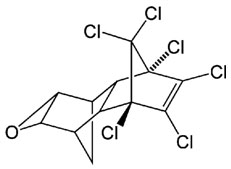 What is Dieldrin?
What is Dieldrin?
Dieldrin is an organochloride originally produced in 1948 as an insecticide. Dieldrin is closely related to aldrin, which reacts further to form dieldrin. Aldrin is not toxic to insects; it is oxidized in the insect to form dieldrin which is the active compound.
Uses
Formerly used as an insecticide; product of oxidized aldrin (former insecticide). All uses except termite control banned in US in 1974; all uses banned in US in 1987.
Sources & Potential Exposure
Aldrin and dieldrin are insecticides with similar chemical structures. They are discussed together in this fact sheet because aldrin quickly breaks down to dieldrin in the body and in the environment. Pure aldrin and dieldrin are white powders with a mild chemical odor. The less pure commercial powders have a tan color. Neither substance occurs naturally in the environment From the 1950s until 1970, aldrin and dieldrin were widely used pesticides for crops like corn and cotton. Because of concerns about damage to the environment and potentially to human health, EPA banned all uses of aldrin and dieldrin in 1974, except to control termites. In 1987, EPA banned all uses.
Federal Regulations
Within the framework of EPA’s Proposed Guidelines for Carcinogen Risk Assessment, it is proposed that the most appropriate cancer risk descriptor for aldrin/dieldrin, relating to the mouse liver tumor response, is ‘not likely a human carcinogen’, a descriptor consistent with the example of phenobarbital cited by EPA.

 Americas
Americas Europe
Europe Français
Français Deutsch
Deutsch Italiano
Italiano Español
Español
